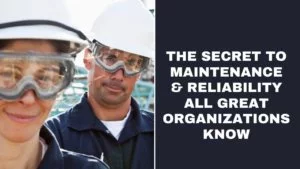In this article, I will explain the roles of execution and motivation in effective maintenance leadership.
Bridging the Know-Do Canyon
There is a small gap between inexperience and knowledge. There is an enormous canyon, however, between knowing and doing.
We know what to do. We know why we should do it. Often, we even know how to do it. Yet most of us don’t change, either as individuals or in the way we run our maintenance program.
The problem is that most improvement efforts are based on the assumption that all you have to do is explain to people that things could be better and then tell them how to do it.
Does that work in real life?
“Smoking and excessive drinking is really bad for you.”
“Oh, really? Well then, I will quit right away.”
Our society would have no smokers, alcoholics, drug addicts, over-drafted credit cards or gamblers if it wasn’t for the fact that it is hard to execute on the principles we know to be true.
In my line of work, I train people in planning and scheduling, root cause analysis, storeroom management and preventive maintenance.
The request for training and consulting is always a pleasant part of the business, but I always try to make a point of asking the potential client, “What will happen after the training is completed?”
The answer is often that there is no plan in place. In many cases, it’s assumed that, for example, root cause training will solve the plant’s problems or that preventive maintenance training automatically will make people build a PM process.
Awareness training is one of the first steps, but we obviously need to remember what we know to be true: Execution is the key, not knowledge by itself.
I refer to the previous four principles in this article series when it comes to ideas on implementing a “doing culture” in your plant.
Motivating Maintenance People
Do we need a different strategy to motivate maintenance people than the one we use for other plant employees? I don’t think so.
A good rule of thumb is that people are people, even if they have funny nicknames taped to their hard hats, are union members or salaried employees. The question of how to motivate people often comes up in plant improvement efforts.
One thing is for sure: A pizza or cheap hat has never, by itself, motivated anyone to do a better job. The grand prize in the category of un-motivating motivation goes to the hospital where my wife worked as a physical therapist for several years.
As a show of appreciation at Christmas time, all staff members were given a roll of Lifesavers candy with the note reading “you are a lifesaver.” How is that for motivation?
How do leaders motivate people? First, realize that few people in this world can motivate and inspire people in masses through rally speeches.
With the exception of Nelson Mandela, Winston Churchill, Mahatma Gandhi and a few others, leaders need to rely on motivating people one-on-one. Leaders must take the time to listen, discuss ideas and challenge approaches with each direct report in order to achieve change.
Pride in our job precedes other incentives for most people. Leaders must therefore provide honest feedback using skillful diplomacy.
In my opinion, pride and recognition of workmanship is more important than any gifts in motivating people, even though money has its place in any improvement effort.
There are too many people dedicated to dangerous and relatively low-paying jobs as soldiers and divers for me to believe money is the No. 1 factor in getting people motivated.
With that in mind, set up the right work processes and closely follow up on the progress to achieve change.





